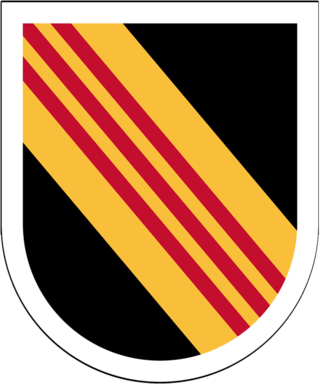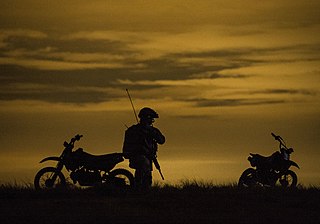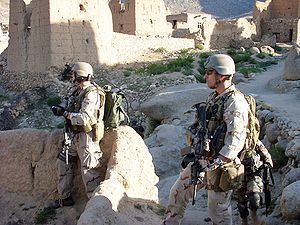
Gary Ivan Gordon was a master sergeant in the United States Army and a recipient of the Medal of Honor. At the time of his death, he was a non-commissioned officer in the United States Army's premier special operations unit, the 1st Special Forces Operational Detachment-Delta (1SFOD-D), or "Delta Force". Together with his comrade, Sergeant First Class Randy Shughart, Gordon was posthumously awarded the Medal of Honor for his actions during the Battle of Mogadishu in October 1993.

The Air Force Cross (AFC) is the United States Air Force and United States Space Force's second highest military decoration for airmen and guardians who distinguish themselves with extraordinary heroism in combat with an armed enemy force. The medal is awarded to any person, while serving in any capacity with the Air Force or Space Force, who distinguish themselves by extraordinary heroism, not justifying the award of a Medal of Honor.

The 5th Special Forces Group (Airborne) (5th SFG (A), 5th Group) is one of the most decorated active duty United States Army Special Forces groups. The 5th SFG (A) saw extensive action in the Vietnam War and played a pivotal role in the early months of Operation Enduring Freedom. 5th Group is designed to deploy and execute nine doctrinal missions: unconventional warfare, foreign internal defense, direct action, counter-insurgency, special reconnaissance, counter-terrorism, information operations, counterproliferation of weapon of mass destruction, and security force assistance.

The 3rd Special Forces Group (Airborne) – abbreviated 3rd SFG(A) and often simply called 3rd Group – is an active duty United States Army Special Forces (SF) group which was active in the Vietnam Era (1963–69), deactivated, and then reactivated in 1990. 3rd Group is designed to deploy and execute nine doctrinal missions: unconventional warfare, foreign internal defense, direct action, counter-insurgency, special reconnaissance, counter-terrorism, information operations, counterproliferation of weapon of mass destruction, and security force assistance. The 3rd SFG(A) was primarily responsible for operations within the AFRICOM area of responsibility, as part of the Special Operations Command, Africa (SOCAFRICA). Its primary area of operations (AO) is now Africa as part of a 2015 SOCOM directive but 3rd Group has also been involved in the Caribbean and the Greater Middle East. The 3rd SFG(A) has seen extensive action in the War on Terror and its members have distinguished themselves on the battlefield in Afghanistan.

The U.S. Army Sniper Course trains selected military members assigned to sniper positions in the skills necessary to deliver long-range precision fire and the collection of battlefield information. Students will receive training in fieldcraft skills, advanced camouflage techniques, concealed movement, target detection, range estimation, terrain utilization, intelligence preparation of the battlefield (IPB), relevant reporting procedures, sniper tactics, advanced marksmanship, and staff subjects.

Sergeant Major Brendan W. O'Connor is a retired Special Forces medical sergeant in the United States Army. On April 30, 2008, he was awarded the Distinguished Service Cross for his heroic action in Afghanistan. The DSC is the nation's second highest award for valor and this was only the second time since the Vietnam War that the medal was awarded.

The United States Air Force Combat Control Teams, singular Combat Controller (CCT), are an elite special operations force who specialize in all aspects of air-ground communication, including air traffic control, fire support, and command, control, and communications in covert, forward, or austere environments.

Zachary James Rhyner is a medically retired Combat Controller (CCT) in the United States Air Force who received the Air Force Cross for his actions in the Battle of Shok Valley on 6 April 2008 in Nuristan Province, Afghanistan. He was the first living, and second ever, Combat Controller to receive the Air Force Cross after TSgt John A. Chapman was posthumously awarded the medal in 2002 for his actions during the Battle of Takur Ghar. He has deployed six times, including Iraq and Afghanistan. He has assisted in humanitarian operations and was a part of Operation Unified Response in Haiti during the aftermath of the 2010 Haiti earthquake.

The Battle of Kamdesh took place during the war in Afghanistan. It occurred on October 3, 2009, when a force of 300 Taliban assaulted the American Combat Outpost ("COP") Keating near the town of Kamdesh in Nuristan Province in eastern Afghanistan. The attack was the bloodiest battle for US forces since the Battle of Wanat in July 2008, which occurred 20 miles (32 km) away from Kamdesh. The attack on COP Keating resulted in 8 Americans killed and 27 wounded while the Taliban suffered 60-150 killed.

The Marine Raider Regiment (MRR), formerly known as the Marine Special Operations Regiment (MSOR), is a special operations forces of the United States Marine Corps, which is a part of Marine Corps Special Operations Command (MARSOC). Renamed for its predecessor, the World War II Marine Raiders, this unit is the principal combat component of MARSOC, which is the Marine Corps' contribution to the United States Special Operations Command (USSOCOM).

This camp was a small American military outpost in Nurestan Province, in Afghanistan. It was originally constructed to be a Provincial Reconstruction Team, called PRT Kamdesh, but due to extremely high levels of fighting in the area it remained a fire base instead of a PRT. In December 2006, it was renamed Camp Keating after the death of ABLE Troop 3-71 Cavalry 10th Mountain Division's executive officer, Benjamin Keating, who died November 26, 2006, when his vehicle turned over in Kamdesh, Afghanistan.

Robert James Miller was a United States Army Special Forces soldier who posthumously received the Medal of Honor for his actions during the War in Afghanistan.

Operational Detachment Alpha 574 is a part of the United States Army's Third Battalion, 5th Special Forces Group. At the beginning of Operation Enduring Freedom it operated in Afghanistan to help defeat the Taliban and create conditions for the establishment of a democratic government in Afghanistan. Jason Amerine was noted for leading the group in several battles of the Invasion of Afghanistan.

The Battle of Ganjgal was a battle in the War in Afghanistan fought between American and Afghan forces and the Taliban in Kunar Province, Afghanistan on September 8, 2009. Complaints that the coalition casualties were avoidable and caused by a failure of the chain of command to provide fire support for the team triggered an official investigation and a series of reprimands to several US military officers. Army Captain William D. Swenson and Marine Corporal Dakota Meyer received the Medal of Honor for their actions during the battle. Meyer is the first living Marine to receive the Medal of Honor since the Vietnam War, and Swenson is the fifth living soldier and second officer to receive the Medal of Honor since the Vietnam War. Two other Marines at the battle, Staff Sgt. Juan Rodriguez-Chavez and Capt. Ademola Fabayo, received the Navy Cross.

Clinton LaVor Romesha is a retired United States Army soldier who received the Medal of Honor for his actions during the Battle of Kamdesh in 2009 during the War in Afghanistan.

The 21st Special Tactics Squadron is one of the special tactics units of the United States Air Force Special Operations Command. It is garrisoned at Pope Field, North Carolina.

The 2014 Gaza Valley airstrike was a friendly fire incident that took place in Zabul Province, Afghanistan on 9 June 2014 when five U.S. troops and one Afghan interpreter were killed when a B-1B Lancer bomber inadvertently dropped laser-guided bombs on their position during a firefight with Taliban forces. U.S. and Afghan government forces were in the Gaza Valley area of Arghandab District conducting security operations in advance of the 2014 Afghan presidential elections when they came under attack from Taliban militants, sparking a firefight. An American air controller on the ground requested close air support from a B-1B bomber flying in the vicinity to support a team of soldiers maneuvering on a ridge. The U.S. aircraft dropped two guided bombs on the position, killing the team of Americans and an Afghan soldier.

Ronald Joseph Shurer II was a United States Army Special Forces staff sergeant and medic. As a senior medical sergeant during the Battle of Shok Valley in April 2008, he and his team were attacked by an enemy force of more than 200 fighters. Shurer fought for more than an hour to reach part of his unit, killing several insurgents along the way. He was initially awarded a Silver Star for this action, but in 2016 The Pentagon upgraded this recognition to a Medal of Honor. He received the latter honor in a White House ceremony on October 1, 2018.

Matthew O. Williams is a sergeant major in the United States Army. He received the Medal of Honor on October 30, 2019, for his actions on April 6, 2008, as a member of Operational Detachment Alpha 3336, Special Operations Task Force 11, Combined Joint Special Operations Task Force-Afghanistan in the Battle of Shok Valley.

Earl D. Plumlee is a Master Sergeant in the United States Army. He was awarded the Silver Star for his actions in Afghanistan that took place on 28 August 2013. His Silver Star was upgraded to the Medal of Honor, and presented to him by President Joe Biden on December 16, 2021; awarded the same day, posthumously, were Alwyn Cashe and Christopher Celiz.






















